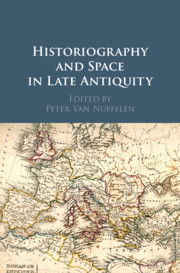Book contents
- Historiography and Space in Late Antiquity
- Historiography and Space in Late Antiquity
- Copyright page
- Contents
- Contributors
- Acknowledgements
- Introduction
- Chapter 1 Constantinople’s Belated Hegemony
- Chapter 2 Beside the Rim of the Ocean
- Chapter 3 Armenian Space in Late Antiquity
- Chapter 4 Narrative and Space in Christian Chronography
- Chapter 5 The Roman Empire in John of Ephesus’s Church History
- Chapter 6 Changing Geographies
- Chapter 7 Where Is Syriac Pilgrimage Literature in Late Antiquity?
- Bibliography
- Index
Chapter 1 - Constantinople’s Belated Hegemony
Published online by Cambridge University Press: 12 August 2019
- Historiography and Space in Late Antiquity
- Historiography and Space in Late Antiquity
- Copyright page
- Contents
- Contributors
- Acknowledgements
- Introduction
- Chapter 1 Constantinople’s Belated Hegemony
- Chapter 2 Beside the Rim of the Ocean
- Chapter 3 Armenian Space in Late Antiquity
- Chapter 4 Narrative and Space in Christian Chronography
- Chapter 5 The Roman Empire in John of Ephesus’s Church History
- Chapter 6 Changing Geographies
- Chapter 7 Where Is Syriac Pilgrimage Literature in Late Antiquity?
- Bibliography
- Index
Summary
By the end of the fourth century, Constantinople, New Rome, had been endowed with a constellation of monuments that collectively signified the City’s centrality in imperial space, in conceptions of time, and the very ordering of the physical world. The Milion, a tetrapylon (or quadrifrons) built by Constantine at the end of the Mese boulevard, stood as a symbolic “zero point” in the geography of empire, analogous to Elder Rome’s Miliarium Aureum.1 The Milion had a clock, called the “clock of the City,” attached to it, thus marking time in addition to space.2 Another massive tetrapylon stood between the fora of Constantine and Theodosius I, and was likely built by the latter: this one featured a huge bronze weathervane at the top of its pyramid in the form of a winged woman, and so was called Anemodoulion, or the “servant of the winds.” Its carvings included images of the personifications of the winds and the tamed natural world, which the monument mapped and measured.3
- Type
- Chapter
- Information
- Historiography and Space in Late Antiquity , pp. 14 - 35Publisher: Cambridge University PressPrint publication year: 2019

